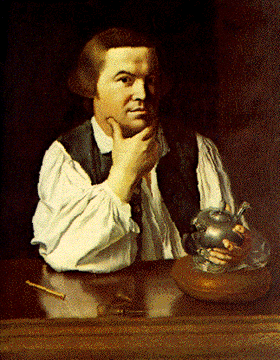Paul Revere - Copper Industry Pioneer
Copper Applications in General Interest
 Paul Revere
Paul ReverePaul Revere is a well known American Patriot. He is best known as a pre Revolutionary War courier, for his ride from Boston to Concord, on April 18, 1775, to warn the colonists that the British were coming. He also participated in the Boston Tea Party and equipped the American Army with needed supplies during the Revolutionary War. However, Paul Revere was also a great craftsman, artisan, industrialist and manufacturer. During his life of 84 years he had many careers and numerous technological achievements. The achievements of Paul Revere included production of the first rolled copper sheets in the US, production of the first cast bell in Boston, and being a major supplier of copper for the US Navy fleet which included nails, bolts, spikes and sheathing.
By 1765, the British placed heavy duties on foreign trade in the colonies. Anti British sentiment in the colonies was rising and patriotic groups were formed. Paul Revere aided the patriotic cause with a series of political cartoons printed from engraved copper plates. The engravings were Paul Revere's first encounter with copper. The plates he made included illustrations for books and magazines, and printed promissory notes of the State of Massachusetts Bay. One famous engraving by Paul Revere was an illustration of the Boston Massacre.
During the Revolutionary War, Paul Revere provided supplies for the Army. Gunpowder was in short supply, so he learned how to make gunpowder and then set up gunpowder mills in Massachusetts. He also cast cannons from iron and brass for the army. After the Revolutionary War, in 1788, he built a furnace on the tip of North Boston Harbor. The furnace was used to make copper spikes, bolts and other ship fittings for American boats.
After a few years, the foundry was used to cast copper alloy bells. Up until that time, the technology to cast bells with good tonal quality was not present in the US and bells were imported from England. With the help of two experienced bell casters, Paul Revere cast the first bell in Boston in 1792. Revere cast a total of 398 bells in the North Boston Foundry and many of the Revere bells still hang in and around Boston today. The bell for King's Chapel in Boston was cast in the North Boston Foundry, it weighed 2437 lbs. and is still used today. A bell for the USS Constitution was also cast in the Revere Foundry, but it was shot away in the historic battle, in the War of 1812, with the British man of war HMS Guerriere.
The American Navy was born in 1792, copper and copper alloys were needed in the shipbuilding industry. Copper bolts, spikes, dovetails, and nails were used to make a ship seaworthy. Copper was also used to sheath the hulls of wooden boats, the sheathing prolonged the life of the vessel, enabled it to go faster and prevented the growth of barnacles. When iron bolts supplied for the USS Constitution were found defective due to rust, Paul Revere replaced the rusted iron bolts with copper bolts. Next, Revere supplied the US Navy with sheathing. Copper was in great demand by the Navy, and Paul Revere was there to meet the Navy's needs.
During the late 18th century, the domestic copper supply was very limited. The modern method of making brass, the direct fusion method, was invented in England in 1787 and the technology remained in England. Therefore all the copper sheet used to make the sheathing was imported from England. By 1800, Paul Revere had discovered the secrets to rolling copper, he was now 65 years old. On October 24, 1801, Paul Revere rolled the first copper sheets in the US. He was able to refine 1800 lbs. of copper at one time using only wood for fuel. He could supply the US Navy with quality copper sheathing that was rolled in the US. The copper sheathed American Navy ships could outfight the best British ships. During the Battle with HMS Guerriere, an American seaman watched a British cannonball bounce off the side of the Constitution, and thus the name "Old Ironsides". All of Robert Fulton's steamboats, including the first steam warship, were sheathed with Revere copper.
In addition to rolling copper sheathing for ships, Paul Revere made sheathing for the new State House in Boston. The State House required 7675 lbs. of copper sheathing and 789 lbs. of copper nails, at a cost of $4232. The roof of the State House in Boston lasted 100 years. The New York City Hall dome was also sheathed with Revere copper.
By 1804 Paul Revere was the accredited head of the copper industry in the US. His output matched the best Britain could produce. By 1812 Revere was supplying three tons of copper per week, most of it going to the US Navy. This was a great time in American history. Paul Revere's copper industry helped to bring about the free enterprise system in American, and his inventive genius helped paved the way for our economic freedom.
Also in this Issue:
- New Copper Alloys: Revised and Reactivated Alloy Compositions
- New Copper Alloys: Compositions of New Copper Alloys
- New Copper Alloys
- ARI and CDA Sponsor Research on Copper Joining Techniques with Future Refrigerants
- The Butte Copper Mines
- Paul Revere - Copper Industry Pioneer
- The History of Brass Making in the Naugatuck Valley
- Environmentally Friendly Permanent Mold Casting
